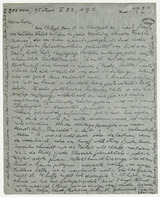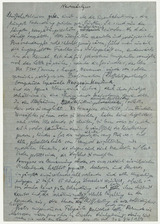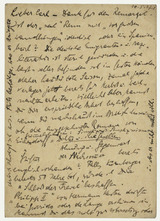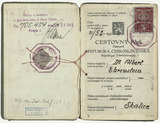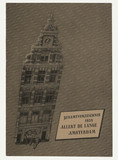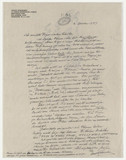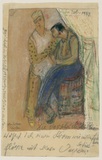Albert Ehrenstein: Letter to his brother Carl (1941)
Two weeks after the traumatic voyage and arrival in New York, Albert Ehrenstein wrote this first letter to his brother Carl in London. In addition to describing the immigrant ship conditions, Albert Ehrenstein reported about his first impressions and new found freedom; about the hope to collaborate on journals and possible publications in German; and also about Switzerland and Spain, among other things.
Albert Ehrenstein: Navemärtyrer (1941)
It was literally in the last moment that Albert Ehrenstein was able to get the required visa to leave Switzerland in the summer of 1941. At the end of his journey through Spain and Portugal, he boarded a converted freighter ship, the “Navemar”, which took him to New York.
Albert Ehrenstein: Postcard to his brother Carl (1937)
During his stay in Switzerland, Albert Ehrenstein lived primarily in Brissago. From here he corresponded, among others, with his brother, who had lived in London since 1928 and had been trying to make his way as a literature agent and translator.
Albert Ehrenstein: Rezension zu Paul Mayers Exil und zu Ludwig Renns Adel im Untergang (1945)
One of the few occupational opportunities open for Albert Ehrenstein in his American exile was reviewing books for German language newspapers and journals. One of his reviews examined two books, which were written in exile in Mexico: Paul Mayer’s poetry collection Exil and Ludwig Renn’s autobiographical-driven novel Adel im Untergang.
Albert Ehrenstein’s Czechoslovakian passport (May 17, 1938)
With the exception of a few travels within Europe, Albert Ehrenstein lived primarily in Switzerland from 1933. During that time, he developed a knack for undercutting as much as possible the strict regulations of the Swiss border police.
Allert de Lange Publisher: Complete catalog 1939
In 1933 a new German language department was opened in the renowned publishing house Allert de Lange in Amsterdam. Numerous German titles were published until 1940, above all the works of exiled authors.
Arnold Schönberg: Letter to Else Lasker-Schüler, October 3, 1937
The composer Arnold Schönberg lived in exile in the US from 1933, and established himself in California. Yet facing the fact that the American public showed only minor interest in his atonal music, he went so far as to compose “old-fashioned“ pieces.
Else Lasker- Schüler: Letter to Emil Raas (1933)
After the National Socialists took power in January 1933, the poet Else Lasker-Schüler immigrated to Switzerland, where she was allowed to stay for a few years. The destitute foreigner, who was never granted a work permit, nonetheless faced many obstacles.
Else Lasker-Schüler: Drawing of Die verscheuchte Dichterin (presumably between 1935-1942)
This drawing, one of the last by the poet, can be seen as a resume of Else Lasker-Schüler’s life in exile. The ficticious comment about the origin being 1933, with the unique quotation from the poem Müde and the motif itself, depicts the poet herself as she seeks support and consolation from an oriental-looking man.
Else Lasker-Schüler: Letter to Emil Raas (1939)
In 1939, the poet Else Lasker-Schüler took her third trip to Palestine. She intended to return to Switzerland, as she normally did.
